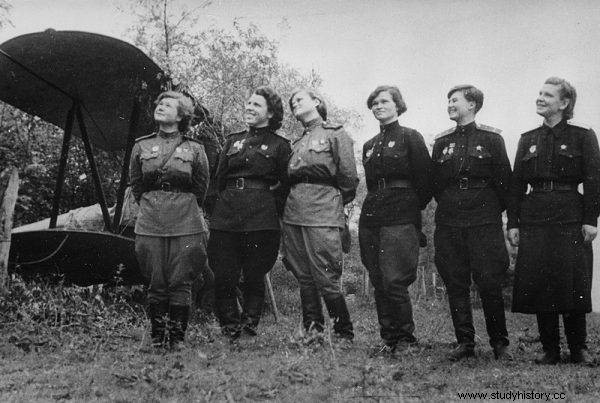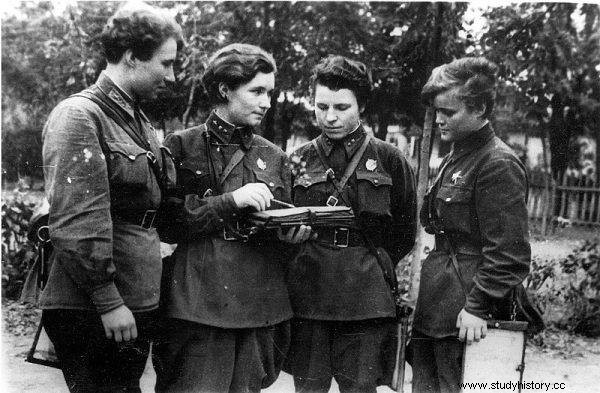46. The Taman Night Bomber Regiment is the only female Soviet Air Force unit. It was the first female formation in the world. The aviators made 23,672 combat flights, and the Germans nicknamed them "night witches". For good reason ...
Where did the name of this unit come from? Well, the flights took place only at night. In addition, the Po-2 planes were light and flew very low, therefore they turned out to be invisible to German radars. Third - the engines of the machines were always turned off when dropping the bombs and only a soft rustling of air was heard, similar to the sound of a broom sweeping the floor ...
The legend begins
The regiment was created on the initiative of the legendary pilot Marina Raskova, the first woman in the USSR, who obtained the privileges of an air navigator. It happened in the early fall of 1941, when the situation at the front was particularly difficult - the enemy was on the outskirts of Moscow and the siege of Leningrad began.
The unit was established on the order of the National Defense Committee of the USSR No. 0099 of October 8, 1941 "On the formation of female aviation regiments of the Red Army Air Force" as the 588th regiment of night bomber aviation (in February 1943, the unit received the status of a guard for special merits).
The head of the formation was Marina Raskowa, the regiment commander was Jewdokija Bierszańska, a 29-year-old trained in blind flights. Absolutely all positions - from pilots to mechanics and technicians - were occupied by women. They were ladies aged 17 to 25, who had already undergone training in aviation clubs before the war broke out.

Absolutely all positions - from pilots to mechanics and technicians - were occupied by women.
The beginnings of the service turned out to be difficult. The girls received worn-out men's flight uniforms and flew old Po-2 planes from the 1920s . These machines had a wood and canvas construction. Initially, they did not have radio communication, so all navigation was carried out using maps. They were not equipped with weapons (the pilots only had pistols), nothing protected them from bullets and bomb fragments. When an enemy hit Po-2, the machine dealt with the fire like a match ...
Hero aviators
The ladies recruited to the night regiment underwent accelerated training and on May 27, 1942, they were at the front. The regiment consisted of 40 two-man crews, not counting maintenance.
At first, the male pilots jokingly called this unit the "Danish Regiment" (the name of "Dane" is associated with a simple and uneducated country girl). But soon they felt the urge to joke, because the aviators proved their qualifications, showing a lot of courage.
The Po-2 had an outdated design and required more skill than the more modern machines at the disposal of the gentlemen. There were no parachutes on the planes on which the "night witches" flew, so when there was a risk of being captured, the pilots often committed suicide by crashing into the ground . There was only room for 2 bombs under the wings, so after the bombardment, the aviators had to return to the base and collect more loads. Often a two-person Po-2 crew made up to 15 flights in one night! The breaks between the courses were only 5-8 minutes.
The aviators showed patriotism and a steadfast psyche. Years later, one of them, Kławdija Dieriabina, recalled:
We were prepared to die. But the most important thing was to remain calm and sober mind in any, even the most unfavorable situation. Before the flight, I always asked my partner for peace, because in life-threatening circumstances fractions of a second count, and when your partner yells at you, you are distracted and you cannot perform the maneuver to save your own and your friend's life.

Night witches fought in the most important operations of the Great Patriotic War
What helped the girls survive in the harsh conditions of war? Dieriabina was an outspoken atheist, but during the flight she had a kind of talisman - photos of her father, brother and sister.
The girls spent 28,676 hours in the air, or 1,191 days. "Night witches" fought in the most important operations of the Great Patriotic War :the Battle of the Caucasus, the liberation of Kubania, Novorossiysk, the Crimea, Belarus, Poland and in the battles in Germany. Women incl. destroyed 46 ammunition depots, many fuel tanks, 9 trains, 2 railway stations. They dropped 3,000 tons of bombs on the enemy. But no less important from a military point of view was the panic they were sowing in the enemy ranks.
For outstanding achievements, 23 airmen were awarded the title of Hero of the Soviet Union. 32 girls died, including Marina Raskowa.
After the war
In August 1945, Stalin organized a parade of athletes in Red Square. American General Dwight Eisenhower was invited. After the parade, the American looked at the military equipment used during the war. He approached the Po-2 plane and for a long time he could not believe that there were women flying on this bomber. Finally, he said, " You don't have to love women to let them fly such a plane ". Upon learning that one of the "witches", Natalia Meklin, was nearby, he approached her, saluted her and kissed her hand.
The women's regiment was dissolved on October 15, 1945. Most of the female aviators were demobilized.
In the Soviet Union, the memory of courageous women was honored. In 1961, the director Siemion Aranowicz made a documentary about them, "A Thousand Hundred Nights", and in 1981, the feature film "There are Night Witches in the Sky" appeared. The streets were named after Marina Raskowa, her face appeared on postage stamps. The fate of aviators also fascinated artists in the West. In the years 2008-2010, the comic book "Le Grand Duc" was published in France, the protagonists of which were Soviet aviators. In 2014, the Swedish band "Sabaton" dedicated the song "Night Witches" to them.
